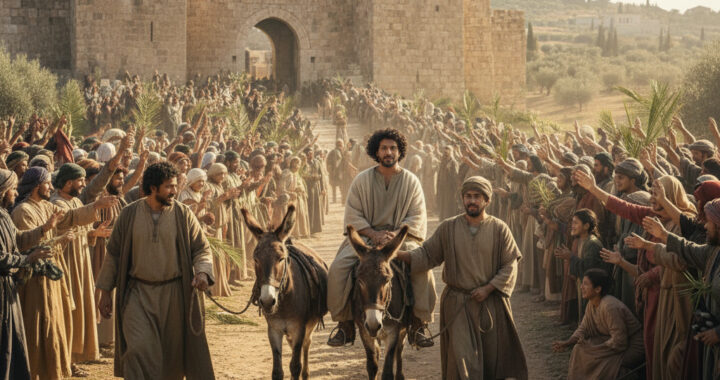Among the most intriguing prophetic sections of the Bible are the prophecies of Zechariah which are contained in the book that bears his name. Zechariah is teeming with Messianic prophecies, recording some of the most detailed Messianic predictions.
Some of Zechariah’s prophecies await future fulfillment (e.g., Zech 14:1-4). However, many of Zechariah’s Messianic prophecies relate to the first advent of Christ and are specifically identified as fulfilled by the Gospel authors in the events surrounding Christ’s Passion.1
Our modest goal of this study is to survey Zechariah’s fulfilled, first-advent Messianic prophecies and to offer some principles that we can learn from these passages. Studying how Zechariah’s first advent prophecies have been fulfilled provides insight into the nature of biblical prophecy and provides us with confidence in God’s future plans.
1. Zechariah 9:9
The first of the Messianic prophecies that we will consider is Zechariah 9:9, which is the well-known prophecy of the Triumphal Entry. Zechariah 9:9 states:
Rejoice greatly, O daughter of Zion;
Shout, O daughter of Jerusalem:
Behold, thy King cometh unto thee:
He is just, and having salvation;
Lowly, and riding upon an ass,
And upon a colt the foal of an ass (KJV).
This promise is found in a succession of prophecies dealing with a Messianic Ruler, who will bring perfect peace (v. 10) and restoration (v. 12). The people of Jerusalem are called to rejoice at the arrival of the King, as He comes bringing justice and salvation, humbly riding on a donkey. After highlighting the humble presentation of the King, the text shifts to discuss His reign (vv. 10-17).
Turning to the New Testament, this prophecy is connected to Jesus’ Triumphal Entry. In Matthew 21, Jesus gave instructions to two of His disciples to go and bring a donkey and her colt to Jesus (v. 2). The disciples did so (v. 6), and Jesus entered Jerusalem with royal fanfare (v. 8) and very definite Messianic accolades (v. 9; cf. Ps 118:26). Matthew specifically ties the Triumphal Entry to Zechariah 9:9 with a quotation formula and citation (v. 4).
John in his parallel account of the Triumphal Entry likewise quotes Zechariah 9:9 to affirm its fulfillment (John 12:15). As these events were unfolding, the disciples did not realize it (v. 16), but afterward they clearly understood that Zechariah 9:9 was fulfilled in the Triumphal Entry.
Aspects of Zechariah’s prophecy were fulfilled very specifically and literally, namely the humble entry of the King into Jerusalem on a donkey. However, some aspects of Zechariah’s 1 See David A. Jones, Old Testament Quotations and Allusions in the New Testament (Bellingham, WA: Logos Bible Software, 2009). 2 prophecy were not fulfilled at that time. The prophecies concerning the perfect rule of the Messiah were not identified as fulfilled by the Evangelists and await a future fulfillment. In this case, the Old Testament prophecy does not clearly distinguish between the two advents of Christ.2 The fact that the Messianic rule was not immediately established does not diminish its validity. It is, in God’s perfect plan, reserved until the second advent.
2. Zechariah 11:12-13
The next Messianic prophecy relates to Jesus’ betrayal, specifically to the price paid to Judas Iscariot to betray Jesus: “thirty pieces of silver.” In Zechariah 11, Zechariah is instructed to act like a shepherd as part of a prophetic word from the LORD (vv. 4-11). In this prophecy, a number of prophetic details are given, including the breaking of the staffs of “Beauty” (v. 10) and “Bonds” (v. 14), apparently prophesying about the dissolution of the nation of Israel as a consequence of their rejection of the LORD. In verses 12 and 13, Zechariah asks for his wages, which is weighted out at thirty pieces of silver (v. 12). He then proceeds to throw it to the potter in the house of the LORD (v. 13).
In the New Testament, these details correlate to the betrayal of Jesus. Judas had contacted the chief priests to see what they were willing to give him to betray Jesus, and they agreed upon thirty pieces of silver (Matt 26:14-15). While this passage lacks a formal quotation formula, it clearly reflects the prophecy of Zechariah, and it sets the stage for Matthew 28:9-10, which does include a quotation formula.
Judas did indeed betray Jesus (Matt 26:47-50), and Jesus was eventually tried and condemned by the chief priest and elders (Matt 27:1-2). Apparently, Judas did not think Jesus would be condemned, so when Jesus was condemned, Judas was filled with grief (not a genuine repentance), and he threw the silver into the temple treasury (27:5). Since it was the price of blood, the chief priests were unwilling to put the money into the treasury (v. 6). Instead, they purchased the Potter’s Field as a burial place for strangers (v. 7). Matthew 27:9-10 states that this action fulfilled prophecy.
In his fulfillment identification, Matthew merges details from Jeremiah (cf. Jer 19:1, 4, 6, 11) and Zechariah. Because of the prominence of Jeremiah, Matthew attributes the prophecy to him in this passage (Matt 27:9).3 Nevertheless, some of the wording is taken from Zechariah and is fulfilled in these events.
The fulfillment of this prophecy is remarkably specific. The amount of the betrayal price, the rejection of the wages, and the reception of the money by the potters are details that are intentional and are fulfilled in a literal way. While the historical fulfillment of these details may seem surprising, these parallels were within the intended meaning of the divine Author and are fulfilled very literally in the historical outworking of God’s plan for the Messiah.
3. Zechariah 12:10
A third significant first-advent, Messianic prophecy in Zechariah relates to the “piercing” of the Messiah. Zechariah 12:10 states:
And I will pour upon the house of David, and upon the inhabitants of Jerusalem,
The spirit of grace and of supplications:
And they shall look upon me whom they have pierced,
And they shall mourn for him, as one mourneth for his only son,
And shall be in bitterness for him, as one that is in bitterness for his firstborn (KJV).
This passage discusses a future attack upon the city of Jerusalem (Zech 12:2-5). At this time, the LORD will supernaturally intervene and save the people of Israel (vv. 6-9). The nation will acknowledge the LORD. They will turn to Him with mourning, apparently recognizing that they had rejected Him and spurned His grace. While the nation had rejected Messiah, they would now receive with mourning the One whom they had pierced.
In John 19:37, the piercing of the Messiah is specifically correlated with the piercing of Jesus’ side (v. 34). Trying to hasten the death of the crucified, the soldiers broke the legs of the other prisoners, but Jesus was already dead (v. 33). Thus, one of the soldiers pierced His side with a spear, verifying that Jesus was dead (v. 34). John points out that this fulfills the Scriptures that no bones would be broken (v. 36; cf. Ps 34:20) and that they shall look on Him whom they pierced (v. 37).
The piercing of the Messiah is a small detail within a larger prophecy concerning the Messiah. However, the piercing of Jesus’ physical body was an important and necessary preliminary fulfillment anticipating that yet-future fulfillment of the prophecy connected with the events surrounding Christ’s second advent (cf. Rev 1:7) and the repentance of national Israel.
4. Zechariah 13:7
The fourth and final Messianic prophecy that will be part of our survey regards the stricken shepherd and the scattering of the disciples. Zechariah 13:7 states:
Awake, O sword, against my shepherd, and against the man that is my fellow,
Saith the LORD of hosts:
Smite the shepherd, and the sheep shall be scattered:
And I will turn mine hand upon the little ones (KJV).
This is another prophecy that pertains to future judgment upon the nation of Israel. Two- thirds of the people will be destroyed (v. 8), and the last third will be purged and refined (v. 9). Those who remain will acknowledge the LORD and will be called His people (v. 10).
In prophesying details about His arrest and betrayal, Jesus informed the disciples that they would all forsake Him. In Matthew 26:31, Jesus cites Zechariah 13:7 to validate this prediction (v. 31). While the disciples, especially Peter, objected to this prediction (vv. 33-35), they did indeed forsake Him after His arrest in Gethsemane (vv. 47-56). This affirmation of fulfilled prophecy is likewise affirmed in the parallel account in Mark 14:27.
This fulfillment is interesting, because it represents an analogy to a larger fulfillment in the tribulation period, which precedes the purging of national Israel. What is fulfilled in the disciples fleeing after Jesus’ arrest anticipates a greater fulfillment of the Jewish people in the Tribulation before they acknowledge their Messiah.4 Nevertheless, an aspect of this prophecy is fulfilled in the arrest of Jesus and dispersion of His disciples.
Implications
As we conclude, I would like to highlight two very important implications from our brief survey. (1) God’s prophetic Word is trustworthy. Several prophecies of Zechariah are specifically identified as fulfilled in the New Testament. These prophecies are a testimony to the accuracy and reliability of prophetic Scriptures and reflect the faithful and trustworthy character of God.
While some of the details in which the prophecies are fulfilled may be surprising, these details are intentional, within the intended meaning of the divine Author, and they are fulfilled in very specific ways. No matter how chaotic the world scene becomes, God will fulfill His plan for the ages, just as He has revealed in biblical revelation.
(2) The details of God’s prophetic revelation are significant. What may seem to be obscure details from the human perspective can reveal significant aspects of God’s future plan. Prophetic details like those from the book of Zechariah show that God will fulfill the specific details of His revelation literally, just as they were intended.
These examples of literal fulfillment affirm an important principle in the interpretation of biblical prophecy: when specific details are given, they will be fulfilled in a specific way. This is particularly important as we interpret prophetic passages that are unfulfilled. I believe that the same exactness of fulfillment that characterized the prophecies of Jesus’ first advent will characterize the fulfillment of the prophecies related to Jesus’ second advent.
This article first appeared in Frontline magazine, fall of 2023. Used with Permission.
Works Cited- See David A. Jones, Old Testament Quotations and Allusions in the New Testament (Bellingham, WA: Logos Bible Software, 2009).[↩]
- F. Duane Lindsey, “Zechariah,” in The Bible Knowledge Commentary: An Exposition of the Scriptures, ed. John F. Walvoord and Roy B. Zuck (Wheaton, IL: Victor, 1983-1985), 1:1563.[↩]
- Louis A. Barbieri Jr., “Matthew,” in The Bible Knowledge Commentary: An Exposition of the Scriptures, ed. John F. Walvoord and Roy B. Zuck (Wheaton, IL: Victor, 1983-1985), 2:86.[↩]
- Lindsey, “Zechariah,” 1:1569.[↩]

Dr. Keith Kobelia
Keith A. Kobelia (PhD, Dallas Theological Seminary) has taught in the Bible and Theology Department at Faith Baptist Bible College since 2014. He, his wife, Elizabeth, and their six children reside in Ankeny, Iowa.

Dr. Keith Kobelia
Keith A. Kobelia (PhD, Dallas Theological Seminary) has taught in the Bible and Theology Department at Faith Baptist Bible College since 2014. He, his wife, Elizabeth, and their six children reside in Ankeny, Iowa.

